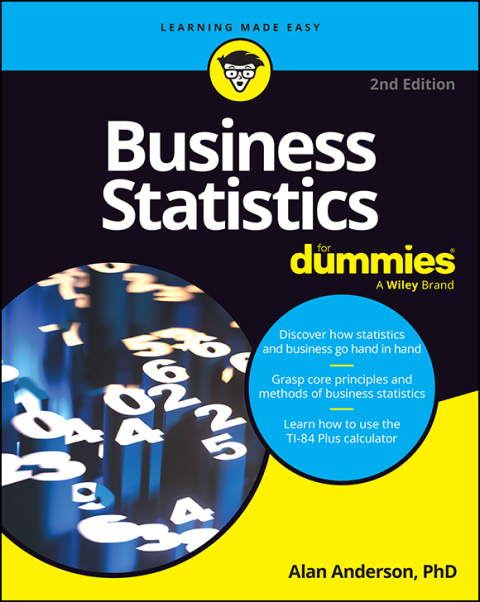Description
Efnisyfirlit
- Cover
- Title Page
- Copyright
- Introduction
- About This Book
- Foolish Assumptions
- Icons Used in This Book
- Beyond the Book
- Where to Go from Here
- Part 1: Getting Started with Business Statistics
- Chapter 1: The Art and Science of Business Statistics
- Representing the Key Properties of Data
- Probability: The Foundation of All Statistical Analysis
- Using Sampling Techniques and Sampling Distributions
- Statistical Inference: Drawing Conclusions from Data
- Chapter 2: Pictures Tell the Story: Graphical Representations of Data
- Analyzing the Distribution of Data by Class or Category
- Histograms: Getting a Picture of Frequency Distributions
- Checking Out Other Useful Graphs
- Chapter 3: Identifying the Center of a Data Set
- Looking at Methods for Finding the Mean
- Getting to the Middle of Things: The Median of a Data Set
- Determining the Relationship Between the Mean and Median
- Discovering the Mode: The Most Frequently Repeated Element
- Computing the Mean, Median, and Mode with the TI-84 Plus Calculator
- Chapter 4: Measuring Variation in a Data Set
- Determining Variance and Standard Deviation
- Finding the Relative Position of Data
- Measuring Relative Variation
- Computing Measures of Dispersion with the TI-84 Plus Calculator
- Chapter 5: Measuring How Data Sets Are Related to Each Other
- Understanding Covariance and Correlation
- Interpreting the Correlation Coefficient
- Computing Covariance and Correlation with the TI-84 Plus Calculator
- Part 2: Probability Theory and Probability Distributions
- Chapter 6: Probability Theory: Measuring the Likelihood of Events
- Working with Sets
- Betting on Uncertain Outcomes
- Looking at Types of Probabilities
- Following the Rules: Computing Probabilities
- Chapter 7: Probability Distributions and Random Variables
- Defining the Role of the Random Variable
- Assigning Probabilities to a Random Variable
- Characterizing a Probability Distribution with Moments
- Chapter 8: The Binomial and Poisson Distributions
- Looking at Two Possibilities with the Binomial Distribution
- Keeping the Time: The Poisson Distribution
- Computing Binomial and Poisson Probabilities with the TI-84 Plus Calculator
- Chapter 9: The Normal Distribution: So Many Possibilities!
- Comparing Discrete and Continuous Distributions
- Understanding the Normal Distribution
- Computing Probabilities for the Normal Distribution with the TI-84 Plus Calculator
- Chapter 10: Sampling Techniques and Distributions
- Sampling Techniques: Choosing Data from a Population
- Sampling Distributions
- The Central Limit Theorem
- Part 3: Drawing Conclusions from Samples
- Chapter 11: Confidence Intervals and the Student’s t-Distribution
- Almost Normal: The Student’s t-Distribution
- Graphing the t-Distribution
- Probabilities and the t-Table
- Point Estimates vs. Interval Estimates
- Estimating Confidence Intervals for the Population Mean
- Computing Confidence Intervals for the Population Mean with the TI-84 Plus Calculator
- Chapter 12: Testing Hypotheses about the Population Mean
- Applying the Key Steps in Hypothesis Testing for a Single Population Mean
- Testing Hypotheses About Two Population Means
- Testing Hypotheses about Population Means with the TI-84 Plus Calculator
- Chapter 13: Applications of the Chi-Square Distribution
- Staying Positive with the Chi-Square Distribution
- Testing Hypotheses about the Population Variance
- Practicing the Goodness of Fit Tests
- Conducing a Goodness of Fit Test with the TI-84 Plus Calculator
- Chapter 14: Applications of the F-Distribution
- Getting to Know the F-Distribution
- Testing Hypotheses about the Equality of Two Population Variances
- Testing Hypotheses about Two Population Variances with the TI-84 Plus Calculator
- Part 4: More Advanced Techniques: Regression Analysis and Spreadsheet Modeling
- Chapter 15: Simple Regression Analysis
- The Fundamental Assumption: Variables Have a Linear Relationship
- Defining the Population Regression Equation
- Estimating the Population Regression Equation
- Testing the Estimated Regression Equation
- Using Statistical Software
- Assumptions of Simple Linear Regression
- Conducting Simple Regression Analysis with the TI-84 Plus Calculator
- Chapter 16: Key Statistical Techniques in Excel
- Implementing Excel Functions
- Checking Out Excel’s Key Statistical Functions
- Going Deeper with the Analysis ToolPak
- Part 5: The Part of Tens
- Chapter 17: Ten Common Errors That Arise in Statistical Analysis
- Designing Misleading Graphs
- Drawing the Wrong Conclusion from a Confidence Interval
- Misinterpreting the Results of a Hypothesis Test
- Placing Too Much Confidence in the Coefficient of Determination ()
- Assuming Normality
- Thinking Correlation Implies Causality
- Drawing Conclusions from a Regression Equation When the Data Do Not Follow the Assumptions
- Using Regression Analysis to Make Predictions About Values Outside the Range of Sample Data
- Placing Too Much Confidence in Forecasts
- Using the Wrong Distribution
- Chapter 18: (Almost) Ten Key Categories of Formulas for Business Statistics
- Summary Measures of a Population or a Sample
- Probability
- Discrete Probability Distributions
- Continuous Probability Distributions
- Sampling Distributions
- Confidence Intervals for the Population Mean
- Testing Hypotheses about Population Means
- Testing Hypotheses about Population Variances
- Using Regression Analysis
- Index
- About the Author
- Advertisement Page
- Connect with Dummies
- End User License Agreement






Reviews
There are no reviews yet.